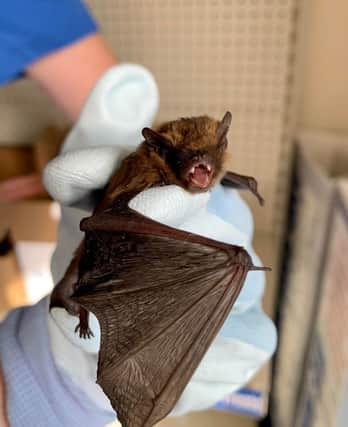NATURE NOTES: Going batty about bats


One of our best known nocturnal creatures is the much-maligned, sometimes even feared, bat. Perhaps it is their association with night, or the myth that they get tangled in your hair, or the more relatively recent idea that they transform into vampires (or is it the other way around?) Either way, we should all cast aside the superstitions and get to know them for the fascinating, beautiful and important beings that they are.
These nocturnal mammals comprise around 1,400 species worldwide, though the UK only has 17 species, unless you can possibly the only UK greater mouse-eared bat, which inhabits a lonely cave in Sussex. This is a fantastic time to see them on warm, calmer evenings. First you will glimpse just a few dark flying shadows as dusk approaches – the first are always exciting. Then, as the night draws in, you may see more and more swooping and soaring. If you are truly lucky, you may hear a magical sound of flapping wings as they chase their insect prey.
Advertisement
Hide AdAdvertisement
Hide AdThere are locations such as caves and abandoned mines where bats will swarm in late summer and autumn. The air becomes thick with flapping wings at a very significant time – the mating season. After this, the females can store the sperm over the winter months, with individuals forming smaller roosts, and then fertilisation can occur in the early spring. These maternity roosts can be large, with thousands of bats, or even tens of millions in other countries, but each mother is still able to find her pup. Meanwhile, the males will be forming smaller roosts elsewhere. This cycle means that bats need a varying number of roosts depending on the time of year, with different temperature and size requirements. In winter, bats will go into a deep ‘torpor’, in order to save energy. This is slightly different to full hibernation in that if the temperature and conditions are right in winter, or they become hungry in spring, bats will emerge to feed.
There are only nine bat species in Northumberland, making identification of some species without specialist equipment slightly easier than it would be further south. Two pipistrelles, soprano and common, are our commonest and most widespread bats, often roosting in buildings. They are relatively small, flying fast and jerkily just above head height up to 10m. The noctule bat is easily recognised by its size – compared to the other species, it is very large, with a wingspan up to 40cm. It rarely roosts in buildings, preferring trees, and it flies over water but mostly on the edge of woodland and along hedgerows. The Daubenton’s bat, on the other hand, is almost exclusively found near water, roosting in tunnels, bridges or caves and flying over water with characteristic pale bellies and ‘dangling’ legs as they use their tail membranes to scoop insects from the water’s surface. Finally, brown long eared bats predominantly pick insects off trees and leaves – they can hover, and will land on the ground to catch insects. If you can look for and recognise these signs, you can already identify over half of Northumberland’s bats! Natterer’s and whiskered bat are less rarely seen, while Brandt’s and Leisler’s are even less common.